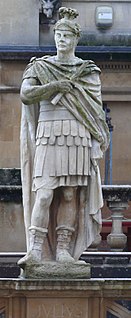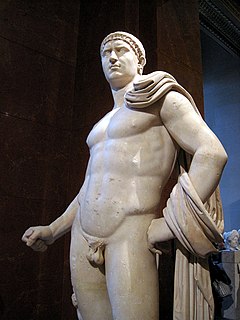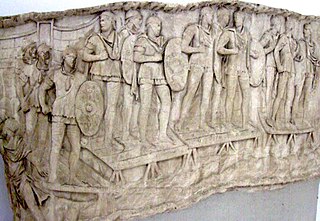
Gnaeus Julius Agricola was a Roman Italo-Gallic general responsible for much of the Roman conquest of Britain. Written by his son-in-law Tacitus, the De vita et moribus Iulii Agricolae is the primary source for most of what is known about him, along with detailed archaeological evidence from northern Britain.

Marcus Otho was the seventh Roman emperor, ruling for three months from 15 January to 16 April 69. He was the second emperor of the Year of the Four Emperors.

Aulus Vitellius was Roman emperor for eight months, from 19 April to 20 December AD 69. Vitellius was proclaimed emperor following the quick succession of the previous emperors Galba and Otho, in a year of civil war known as the Year of the Four Emperors. Vitellius was the first to add the honorific cognomen Germanicus to his name instead of Caesar upon his accession. Like his direct predecessor, Otho, Vitellius attempted to rally public support to his cause by honoring and imitating Nero who remained widely popular in the empire.

The Battle of Adrianople, sometimes known as the Battle of Hadrianopolis, was fought between an Eastern Roman army led by the Eastern Roman Emperor Valens and Gothic rebels led by Fritigern. The battle took place in the vicinity of Adrianople, in the Roman province of Thracia. It ended with an overwhelming victory for the Goths and the death of Emperor Valens.

Gaius Suetonius Paulinus was a Roman general best known as the commander who defeated the rebellion of Boudica.

The Revolt of the Batavi took place in the Roman province of Germania Inferior between AD 69 and 70. It was an uprising against the Roman Empire started by the Batavi, a small but militarily powerful Germanic tribe that inhabited Batavia, on the delta of the river Rhine. They were soon joined by the Celtic tribes from Gallia Belgica and some Germanic tribes.

The Year of the Four Emperors, AD 69, was the first civil war of the Roman Empire, during which four emperors ruled in succession: Galba, Otho, Vitellius, and Vespasian. It is considered an important interval, marking the transition from the Julio-Claudians, the first imperial dynasty, to the Flavian dynasty. The period witnessed several rebellions and claimants, with shifting allegiances and widespread turmoil in Rome and the provinces.

The Battle of Mons Graupius was, according to Tacitus, a Roman military victory in what is now Scotland, taking place in AD 83 or, less probably, 84. The exact location of the battle is a matter of debate. Historians have long questioned some details of Tacitus's account of the fight, suggesting that he exaggerated Roman success.
Aulus Caecina Alienus was a Roman general, was born in Vicetia.
The Battle of Bedriacum refers to two battles fought during the Year of the Four Emperors near the village of Bedriacum, about 35 kilometers (22 mi) from the town of Cremona in northern Italy. The fighting in fact took place between Bedriacum and Cremona, and the battles are sometimes called "First Cremona" and "Second Cremona".

The Auxilia were introduced as non-citizen troops attached to the citizen legions by Augustus after his reorganisation of the Imperial Roman army from 30 BC. By the 2nd century, the Auxilia contained the same number of infantry as the legions and, in addition, provided almost all of the Roman army's cavalry and more specialised troops. The auxilia thus represented three-fifths of Rome's regular land forces at that time. Like their legionary counterparts, auxiliary recruits were mostly volunteers, not conscripts.
Julius Briganticus was a Batavian who commanded auxiliary cavalry in the Roman Army. He was the son of the sister of Gaius Julius Civilis, the leader of the Batavian rebellion, who apparently hated his nephew. The nomen Julius indicates he was a Roman citizen. The cognomen Briganticus perhaps suggests he, or his father, gained distinction fighting against the Brigantes of northern Britain.
Julius Classicus was a Gaulish nobleman and military commander of the 1st century AD, belonging to the tribe of the Treviri. He served as a commander of the Roman auxiliaries. Along with Julius Tutor, another Treviran Roman auxiliary commander, and Julius Sabinus, who claimed descent from Gaius Julius Caesar, he joined the rebellion of Gaius Julius Civilis during the disorder of the Year of the Four Emperors.

The Batavi was an auxilia palatina (infantry) unit of the late Roman army, active between the 4th and the 5th century. It was composed by 500 soldiers and was the heir of those ethnic groups that were initially used as auxiliary units of the Roman army and later integrated in the Roman Empire after the Constitutio Antoniniana. Their name was derived from the people of the Batavi.
Fabius Valens of Anagnia was a Roman commander favoured by Nero. In 69 he was commander of Legio I Germanica based in Germania Inferior. When the troops refused to endorse the new emperor Galba after Nero's death, he had them proclaim Vitellius, the governor of Germania Inferior, as emperor.
The Battle of Baduhenna Wood was a battle, possibly fought near Heiloo, Netherlands, in 28 AD between the Frisii and a Roman army led by the Roman general Lucius Apronius.
Aulus Marius Celsus was a Roman senator who held several offices in the emperor's service during the first century AD, as well as playing a role in the Year of Four Emperors. He was suffect consul of the nundinium of July to August 69 as the colleague of Gnaeus Arrius Antoninus.
Appius Annius Gallus was a Roman senator and general who flourished during the first century. He held the office of suffect consul in 67 with Lucius Verulanus Severus as his colleague. The suffect consul of 67 is commonly identified as the general who supported Otho during the Year of the Four Emperors.
Gaius Valerius Paulinus was a Roman eques who flourished during the reign of the emperors Nero, and Vespasian. He was appointed to a series of imperial offices, including praefectus or governor of Roman Egypt. Ronald Syme has strongly suggested that Paulinus is the father of the identically named Gaius Valerius Paullinus, suffect consul in 107.